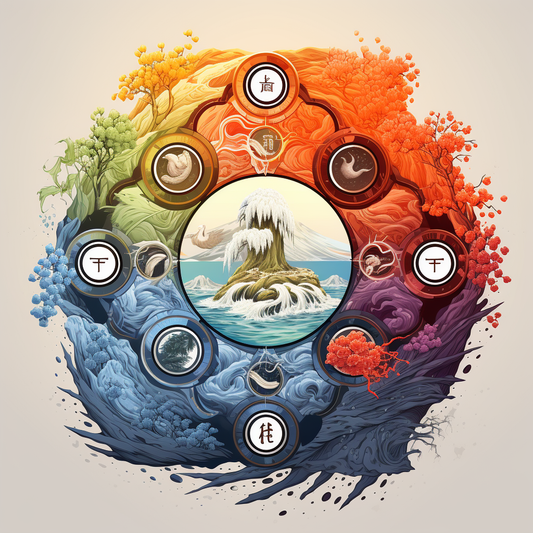What is Yin Yang?
Share
Yin Yang are a pair of categories in ancient Chinese philosophy. The initial meaning of yin and yang is very simple, indicating the direction of sunlight, sunlight is yang and sunlight is yin, which was later extended to the warmth and coldness of the climate, the up and down, left and right, inside and outside, and the agitation and tranquility of the state of movement, and so on. Ancient Chinese philosophers then realized that all phenomena in the natural world have a relationship of mutual antagonism and interaction, and used the concept of yin and yang to explain the two opposing and reciprocal material forces in the natural world, and believed that the antagonism of yin and yang and the elimination of yin and yang are inherent in the things themselves, and then believed that the antagonism of yin yang and elimination of yin and yang are the basic laws of the universe.
The doctrine of yin and yang holds that the world is a material whole, and that everything in nature consists of two opposing aspects, yin yang, and that the two opposing sides are unified with each other. The movement of the unity of opposites of yin yang is the fundamental reason for the occurrence, development, change and demise of all things in nature. As the “Suwen yin yang should be like the theory” said yin and yang, the way of heaven and earth, the program of all things, the parents of change, life and death of the beginning. Therefore, the contradictory opposites and unity of the law of movement of yin and yang is the inherent law of all things in nature, the world itself is the result of the unity of movement of yin and yang.
Yin yang, both can be expressed in opposition to each other, and can be used to analyze the existence of a thing within the two opposing aspects. Generally speaking, all the vigorous movement, outward, upward, warm, bright, belong to the Yang; relatively stationary, inward, downward, cold, dark, belong to the Yin. In terms of heaven and earth, the weather is light and clear as yang, and the earth is heavy and turbid as yin; in terms of fire and water, the water is cold and moist as yin, and the fire is hot and hot as yang.
Anything can be divided into yin yang attributes, but only if it is a pair of interrelated things, or two aspects of a thing, does this division have practical significance. If the two things being analyzed are not related to each other, or are not two opposing aspects of a unity, yin yang cannot be used to differentiate their relative attributes and their interrelationships.
The yin yang attributes of things are not absolute, but relative. This relativity, on the one hand, is manifested in certain conditions, yin and yang can be transformed into each other, that is, yin can be transformed into yang, yang can also be transformed into yin. On the other hand, it is reflected in the infinite divisibility of things.
The basic content of the doctrine of yin yang includes four aspects: yin yang opposites, yin yang mutual roots, yin yang extinction and yin yang transformation.
In the theoretical system of Chinese medicine, the ideas of the yin-yang doctrine are reflected everywhere. The doctrine of yin and yang is used to explain the organizational structure, physiological functions and pathological changes of the human body, and to guide the diagnosis and treatment of diseases.
The doctrine of yin and yang holds that the world is a material whole, and that everything in nature consists of two opposing aspects, yin yang, and that the two opposing sides are unified with each other. The movement of the unity of opposites of yin yang is the fundamental reason for the occurrence, development, change and demise of all things in nature. As the “Suwen yin yang should be like the theory” said yin and yang, the way of heaven and earth, the program of all things, the parents of change, life and death of the beginning. Therefore, the contradictory opposites and unity of the law of movement of yin and yang is the inherent law of all things in nature, the world itself is the result of the unity of movement of yin and yang.
Yin yang, both can be expressed in opposition to each other, and can be used to analyze the existence of a thing within the two opposing aspects. Generally speaking, all the vigorous movement, outward, upward, warm, bright, belong to the Yang; relatively stationary, inward, downward, cold, dark, belong to the Yin. In terms of heaven and earth, the weather is light and clear as yang, and the earth is heavy and turbid as yin; in terms of fire and water, the water is cold and moist as yin, and the fire is hot and hot as yang.
Anything can be divided into yin yang attributes, but only if it is a pair of interrelated things, or two aspects of a thing, does this division have practical significance. If the two things being analyzed are not related to each other, or are not two opposing aspects of a unity, yin yang cannot be used to differentiate their relative attributes and their interrelationships.
The yin yang attributes of things are not absolute, but relative. This relativity, on the one hand, is manifested in certain conditions, yin and yang can be transformed into each other, that is, yin can be transformed into yang, yang can also be transformed into yin. On the other hand, it is reflected in the infinite divisibility of things.
The basic content of the doctrine of yin yang includes four aspects: yin yang opposites, yin yang mutual roots, yin yang extinction and yin yang transformation.
In the theoretical system of Chinese medicine, the ideas of the yin-yang doctrine are reflected everywhere. The doctrine of yin and yang is used to explain the organizational structure, physiological functions and pathological changes of the human body, and to guide the diagnosis and treatment of diseases.



